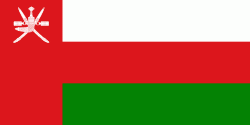Khasab
Khasab (خَصَب) is a city and local capital of the Musandam Governorate which is an exclave of Oman bordering the United Arab Emirates at the tip of the Musandam Peninsula by the Strait of Hormuz. It has been dubbed the "Norway of Arabia" because of its extensive fjord-like craggy inlets and desolate mountainscapes.
Khasab is a small city when compared to nearby cities of the United Arab Emirates. It has many residents who mostly live in mainland Oman and come to Khasab for vacations. There is a huge population of Indians, Pakistanis and Bangladeshis, like in mainland Oman, who work in restaurants, grocery stores, supermarkets, tour operators and many other places.
The city is surrounded by the northern mountains of the Western Hajar Range. Khasab has a fully functional hospital and several hotels, beaches and parks across the city. The city's population is dominated by ethnic Omanis from the mainland. Khasab also has a fort which is known as Khasab Fort. The sea port is dominated by the dhows which take tourists for a cruise across the natural, dry "fjords".
The city is frequently visited by residents of UAE as the Khasab Coastal Road provides access to the city from UAE by connecting with the E11 Highway in the UAE side. The city can also be accessed by the ferry which is maintained by the Government. The ferries are modern.
The Portuguese built Khasab at the beginning of the 17th century, at the height of their naval presence in the region. The natural harbour gave shelter from rough seas. Unlike many forts, which were built on high ground for defensive purposes, Khasab was designed as a supply point for dates and water for Portuguese ships sailing through the strait. Today, Khasab is protected from floods by three large dams.
Khasab is a small city when compared to nearby cities of the United Arab Emirates. It has many residents who mostly live in mainland Oman and come to Khasab for vacations. There is a huge population of Indians, Pakistanis and Bangladeshis, like in mainland Oman, who work in restaurants, grocery stores, supermarkets, tour operators and many other places.
The city is surrounded by the northern mountains of the Western Hajar Range. Khasab has a fully functional hospital and several hotels, beaches and parks across the city. The city's population is dominated by ethnic Omanis from the mainland. Khasab also has a fort which is known as Khasab Fort. The sea port is dominated by the dhows which take tourists for a cruise across the natural, dry "fjords".
The city is frequently visited by residents of UAE as the Khasab Coastal Road provides access to the city from UAE by connecting with the E11 Highway in the UAE side. The city can also be accessed by the ferry which is maintained by the Government. The ferries are modern.
The Portuguese built Khasab at the beginning of the 17th century, at the height of their naval presence in the region. The natural harbour gave shelter from rough seas. Unlike many forts, which were built on high ground for defensive purposes, Khasab was designed as a supply point for dates and water for Portuguese ships sailing through the strait. Today, Khasab is protected from floods by three large dams.
Map - Khasab
Map
Country - Oman
 |
 |
| Flag of Oman | |
From the 17th century, the Omani Sultanate was an empire, vying with the Portuguese and British empires for influence in the Persian Gulf and Indian Ocean. At its peak in the 19th century, Omani influence and control extended across the Strait of Hormuz to Iran and Pakistan, and as far south as Zanzibar. When its power declined in the 20th century, the sultanate came under the influence of the United Kingdom. For over 300 years, the relations built between the two empires were based on mutual benefit. The UK recognized Oman's geographical importance as a trading hub that secured their trading lanes in the Persian Gulf and Indian Ocean and protected their empire in the Indian sub-continent. Historically, Muscat was the principal trading port of the Persian Gulf region.
Currency / Language
| ISO | Currency | Symbol | Significant figures |
|---|---|---|---|
| OMR | Omani rial | رع. | 3 |
| ISO | Language |
|---|---|
| AR | Arabic language |
| EN | English language |
| UR | Urdu |















